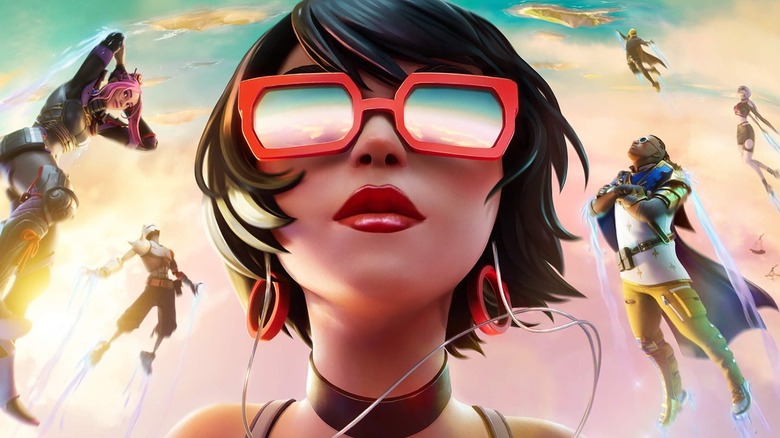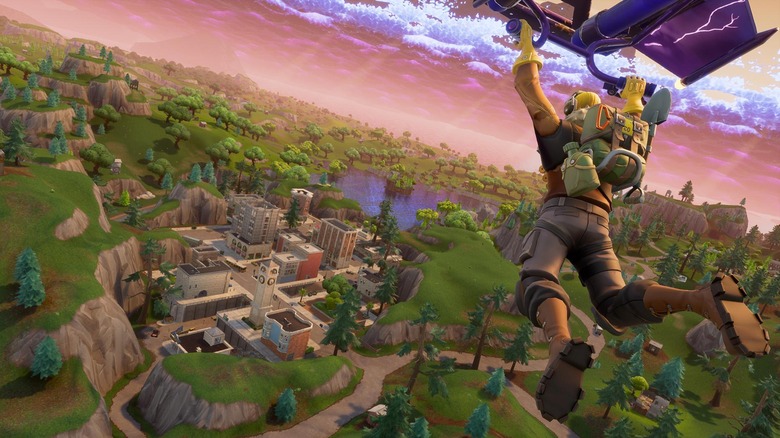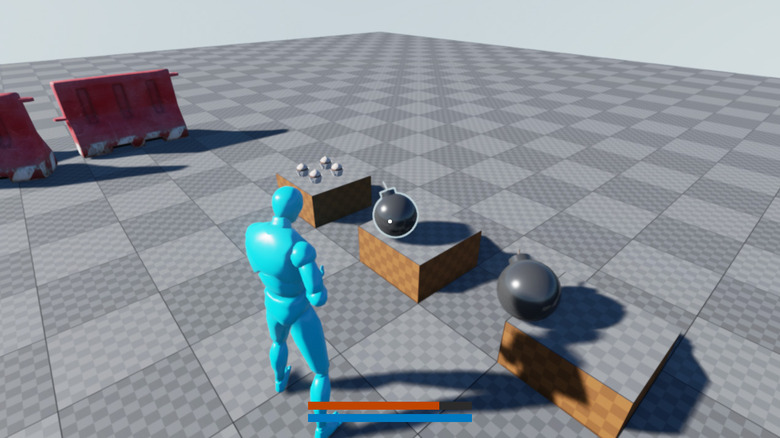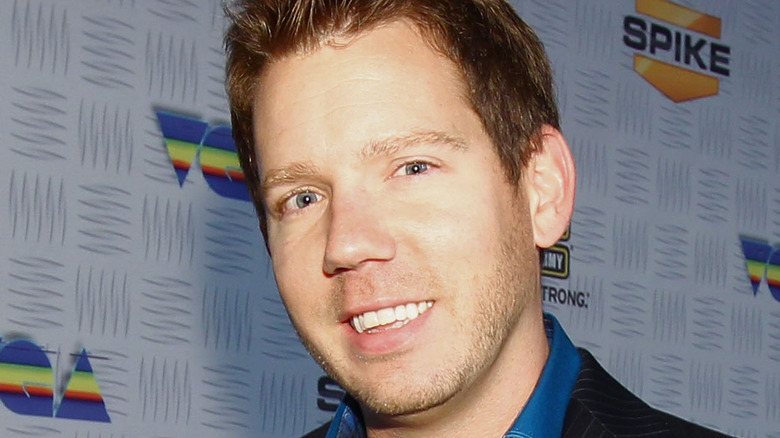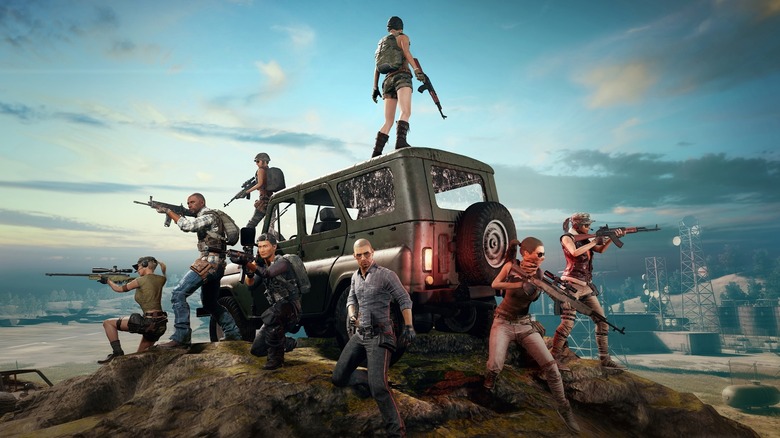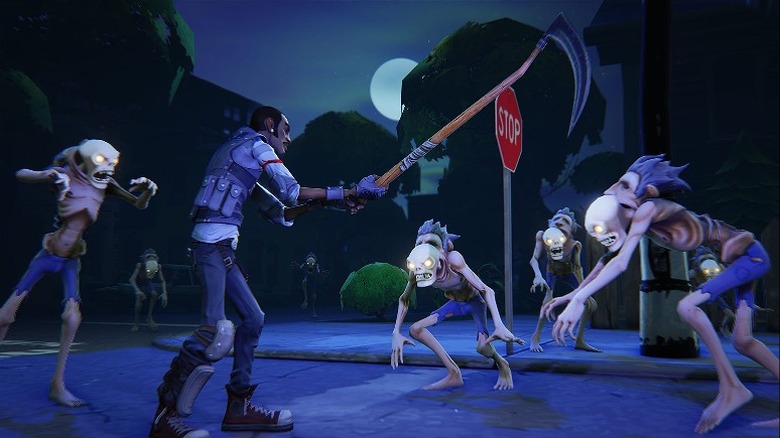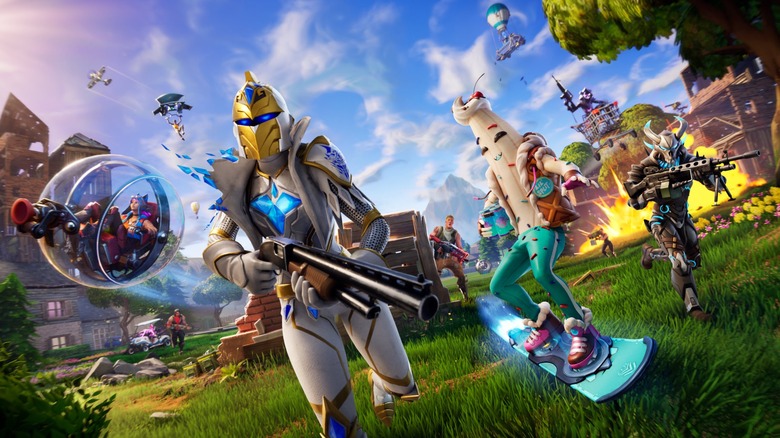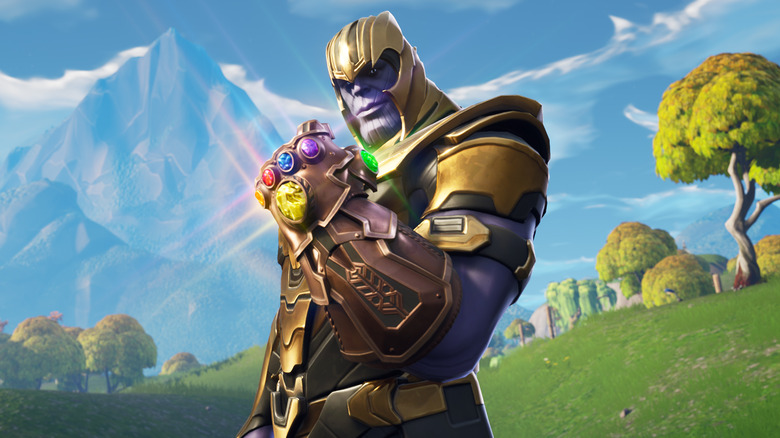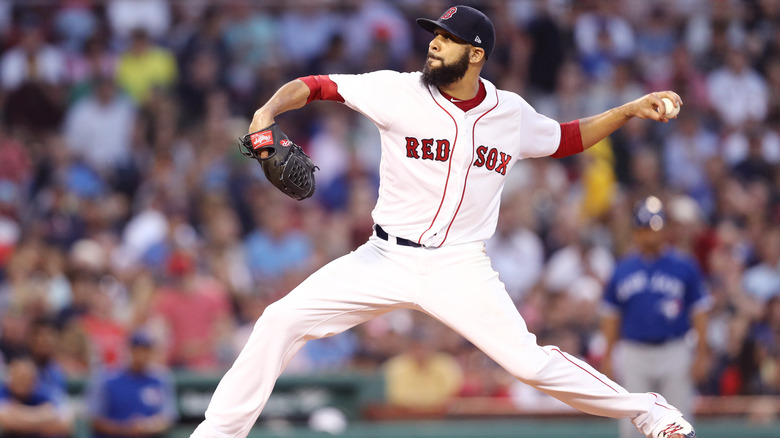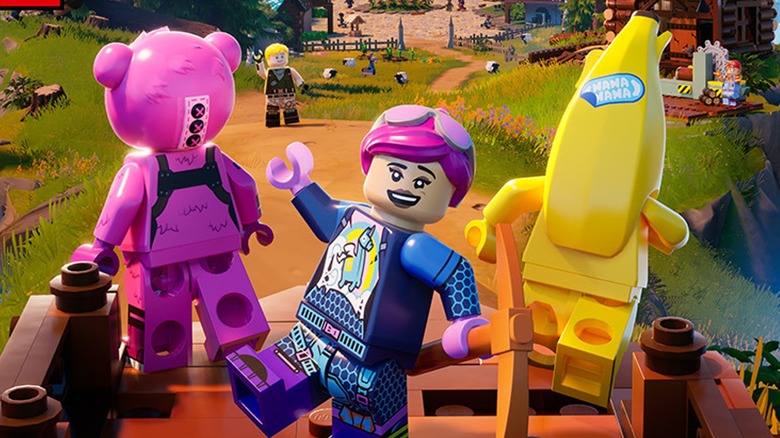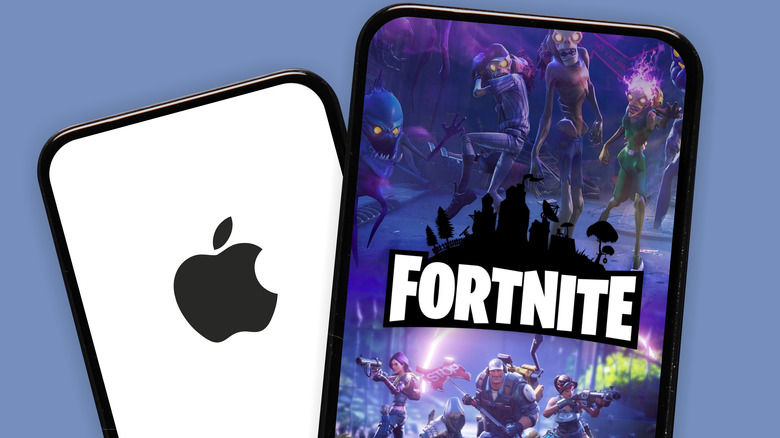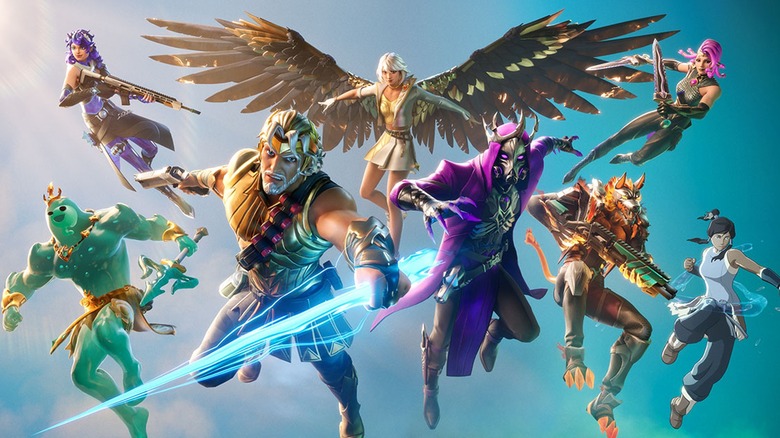The Untold Truth Of Fortnite
For well over half a decade, "Fortnite" has been a go-to multiplayer title for gamers all around the world. The game launched into early access back in 2017, and it almost instantly took the world by storm. Within just two weeks, "Fortnite" had pulled in over 10 million players, and thought its popularity has ebbed and flowed since then, it's quite clear that "Fortnite" is here to stay.
Since then, "Fortnite" has continued to grow, and so have some of the game's biggest fans. "Fortnite" helped Tyler "Ninja" Blevins transform into a world famous streamer, and it's become a place where so many other streamers and gamers gather, find friends, and play. People still excitedly jump into new "Battle Royale" seasons, even if those seasons have completely divisive themes. But today, "Fortnite" has evolved to feature game modes for fans of co-op shooters, creative building games, and even good 'ol "Guitar Hero." "Fortnite" is a world unto itself, so let's dig back through that world's history and take a look at how a simple free-to-play game became one of the most popular franchises in the entire gaming industry.
From flop to phenomenon in 63 days
As most fans know, "Fortnite" didn't start as a self-conscious take on the battle royale-style gameplay popularized by "PUBG." It was initially pitched as a mash-up between "Minecraft" and co-op zombie shooter "Left 4 Dead." In fact, "Fortnite: Save the World," which pits teams of players against hordes of monsters, forcing them to build forts to survive the carnage, hit early access on July 25, 2017.
But it's "Fortnite: Battle Royale," not "Save the World," that turned "Fortnite" into a bona fide hit. Here's the funny thing: While it took six years for players to get their hands on "Save the World," "Battle Royale" was made in a mere two months. It wasn't started until after "Save the World" launched, and wasn't free-to-play until two weeks before release. All in all, that's a remarkably fast turnaround time, and Epic Games' Ed Zobrist says it probably couldn't have been done at a bigger publisher. In fact, in order to get things finished on schedule, Epic had to borrow members from its "Unreal Tournament team" for some extra last-minute help. It was the right call. While "Fortnite: Save the World" received mediocre reviews, "Fornite: Battle Royale" more or less conquered the gaming world overnight.
A flagship game that never set sail
"Fortnite" is playable on everything from top-end PCs to phones, but that wasn't always the plan. At first, "Fortnite" was planned as a PC-exclusive. In fact, Epic intended to use Fortnite as a showcase for the latest iteration of its Unreal Engine. In 2012, former Epic spokesperson and longtime designer Cliff Bleszinski told a crowd at San Diego Comic-Con that "Fortnite" "is a PC-designed game, it's shipping exclusively for the PC." Not only is PC gaming an important part of Epic's heritage, Bleszinski said, but the then-new Unreal Engine was (at the time) so advanced that it only made sense to run it on top-end PCs. "Next-gen's here," Bleszinski elaborated. "It's been here. It's a high-end PC." In fact, the Unreal Engine 4 was developed specifically for "Fortnite." The game was simply too big to run on Unreal Engine 3, and early in production Epic realized that the game would need a whole new engine. So, the company built one.
"That's not how things panned out, of course. Unreal Engine 4 was ready for prime time in 2014 while "Fortnite" was still in development, so Epic decided to release the engine without its signature title. Since then, Unreal Engine 4 has gone one to power all kinds of interesting games — including "PUBG."
So long, CliffyB
In its own way, "Fortnite" helped to part its parent studio from its most famous developer. As the man behind "Gears of War" and "Unreal Tournament," Cliff "CliffyB" Bleszinski spent two decades as the public face of Epic Games. That ended in 2012, when Bleszinski resigned from both the company and the game industry itself (Bleszinski later returned to game development, but the less said about that, the better).
In an official statement, Bleszinski blamed his departure on burnout, and that's a fine excuse. After all, he had been making video games for 20 years. Still, it looks like "Fortnite" may have played a part in Bleszinski's resignation, too. In 2012, Epic wanted to move to a "games as a service" business model (in which the product is supported with new content over a long period of time), and decided to use "Fortnite" to spearhead the transition. Epic reached out to Chinese game publisher Tencent for help. Before long, Tencent owned 40% of the company.
That gave Bleszinski the perfect opportunity to make his exit. As Bleszinski told Polygon, he wasn't particularly thrilled with Epic's new direction, and the style of "Fortnite" wasn't really his cup of tea, either. After contract re-negotiations fell through, Bleszinski stopped showing up to work. Epic founder Tim Sweeney tracked him down and told him to make a decision. Bleszinski handed in a letter of resignation the next day and sold his shares in Epic to Tencent.
PUBG vs. Fortnite
Early into the game's run, "Fortnite" found an adversary in Krafton Studios, formerly known as the PUBG Corporation. It's easy to see why. Not only has Epic admitted that "Fortnite: Battle Royale" was directly inspired by "PUBG," but Epic also makes the Unreal engine, which powers both "Fortnite" and "PUBG." From the beginning, that's made Krafton very nervous. In December 2017, Brendan Greene — PlayerUnknown himself — threw shade at would-be copycats, calling for greater protections for small developers and accusing rip-offs of hurting the overall market. "If it's just copycats down the line," Greene said (via GamesIndustry.biz), "then the genre doesn't grow and people get bored."
Still, the battle royale genre itself isn't owned by Krafton, and when PUBG Corporation sued Epic in 2018 for copyright infringement, it did so in a South Korean court, not an American one. It didn't really matter. PUBG Corporation dropped the suit a month later, but Krafton later filed another suit in 2022. The future of this battle is still uncertain, but one thing's for sure: Krafton is not happy seeing "Fortnite" continually stomping "PUBG" in the Steam charts.
Cute and cuddly carnage
The Pixar-esque art style of "Fortnite" helps the game stand out against and all of the other battle royales on the market. The cartoony graphics are often credited as one of the main reasons why kids prefer "Fortnite" to the competition. Unlike "PUBG," which is much more grounded, "Fortnite" has a quirky sense of humor, and its matches feel light, whimsical, and fun — as fun as getting virtually shot in the face by strangers can be, anyway.
Well, that wasn't always the case. In fact, "Fortnite: Save the World" looked dark and serious in early development. Unfortunately, that was a little too dark, and it wore on players after extended play sessions. "We're hoping that people spend dozens if not hundreds of hours in this world," Cliff Bleszinski told fans at PAX Prime 2012 (via Eurogamer). And so, Epic got to work making the game look like the kind of place you'd want to hang out for hours on end. Epic's design team literally went back to the drawing board, looking to Pixar films, Tim Burton flicks, and 1950s "Looney Tunes" shorts for inspiration.
It's hard to argue with the results. Not only does the simple art style ensure that "Fortnite" will run on machines of differing power levels, but it gives Epic room to indulge in all kinds of silliness. It's hard to imagine TomatoHead or the Orange Shirt Kid dance popping up in other battle royales' grim 'n gritty worlds. In "Fortnite," they fit right in.
A billion-dollar early access game
Unprecedented popularity and a dizzying array of brand deals brought a ton of money into "Fortnite." It's no secret that the gaming industry can be a lucrative space when a game hits it big, but "Fortnite" really helped change people's expectations for just how much money a game can earn. By July 2018, "Fortnite" had made over a billion dollars, making it not just one of the most financially successful video games of all time, but also one of the most lucrative pieces of entertainment, period.
That billion-dollar profit is already impressive, but what makes it even so noteworthy is that back in 2018, "Fortnite" wasn't even considered a "full" game, depending on your definition. "Fortnite" didn't come out of early access until 2020, roughly three years after it first took the world by storm. The jump from early access to finished game came along with a PvE game mode called "Fortnite: Save the World," which Epic decided to turn into a premium, paid experience rather than making it a part of the other free-to-play game modes in "Fortnite." By then, the company had long since proven that it could make plenty of money without charging gamers up front, so while it was rolling out "Save the World," it was already laying the groundwork for the next stage of the game's evolution.
Emotes accused of cultural appropriation
If you've played (and lost) a fair amount of "Fortnite," you've probably watched a competitor boogie on top of your bullet-ridden corpse. If not, you're still probably familiar with the game's dance-like emotes in some way. Heck, France's Atlético Madrid even performed the game's iconic "Take the L" emote during the World Cup 2018 finals, bringing "Fortnite" to one of the biggest stages imaginable for the first time. But emotes aren't just fun; they're also big business. Players purchase some emotes using real-life money, and that has translated into some massive profits for Epic Games. It's also raised the ire of some members of the hip-hop community, who have accuse Epic of profiting off of Black performers' hard work.
See, many "Fortnite" emotes are based on existing dances. As Chance the Rapper said, "Black creatives created and popularized these dances but never monetized them." 2 Milly, whose "Milly Rock" dance appears in "Fortnite" as the aptly-named "Swipe It" emote, agrees. "I don't feel it's appropriate that my art (dance) which is a big part of culture is basically stolen," Milly told Kotaku. "Fortnite" has its fans in the hip-hop world, of course (Lil Yachty even devoted a music video to it). Still, Chance, 2 Milly, and others have continued to call out "Fortnite" for cultural appropriation. That's a valuable discussion, and one that probably won't be ending any time soon.
Thanos elevated Fortnite crossovers to a new level
In May 2018, the biggest superhero movie of all time invaded the most talked-about game of the year. Thanos left the Marvel Cinematic Universe and brought his Infinity Gauntlet to "Fortnite," where he promptly began wreaking havoc. But how did that happen? According to everyone involved, it was a snap. See, like practically everyone else, "Avengers: Infinity War"/"Endgame" directors Joe and Anthony Russo are big "Fortnite" fans, and they played it whenever they needed a break from editing the Avengers' latest big-screen adventure. In fact, it was their idea to put Thanos in the game, not Epic's. "We started thinking, how cool would it be to have some kind of Avengers–Fortnite mashup?," Joe Russo told Entertainment Weekly.
The two directors reached out to Donald Mustard, Epic Games' worldwide creative director. "It had to be super authentic to both 'Fortnite' and the 'Avengers: Infinity War,'" Mustard says, "and something that fans of both would be excited about." Mustard and the Russos brainstormed on the phone for about an hour and came up with a rough plan, and then Epic's developers got to work. The crossover was a huge hit, even leading to a scene in which Thor plays "Fortnite" in "Avengers: Endgame."
Fortnite is throwing professional athletes a curveball
Poor David Price. In May 2018, the former Cy Young winner and five-time All-Star missed a game against the the Red Sox's age-old enemies, the Yankees, thanks to carpal tunnel syndrome. In the aftermath, word quickly spread about the pitcher's Fortnite addiction. Fans weren't happy. Price denied that the injury was Fortnite-related, but the Boston press piled on anyway, and Price ultimately vowed to stop playing the game — at least while he's at the ballpark.
At least Price wasn't alone. In fact, the 32-year-old Price only learned about Fortnite because, as Fox Sports reports, so many of his younger teammates were already playing it. Privately, some people involved in the NBA have expressed concern that young players are spending all night playing "Fortnite." When Derrius Guice, a top-rated football prospect, wasn't picked during the first round of the NFL draft, many blamed his ongoing "Fortnite" habit.
On the opposite side of things, some athletes have seen their gaming time impacted by their main gig. When the Miami Dolphins' Tyreek Hill hurt his hand during an intense play, he reassured reporters that he wouldn't be benched for the teams' upcoming game against the Jets — but noted that he was worried about his battle royale skills. "I think I'll be fine," Hill said. "The only thing I'm really bummed about, I won't be able to play "Fortnite."
Crossovers and collabs have become the business model
"Fortnite" fans couldn't have been more excited about the game's "Avengers: Infinity War" crossover event, and Epic took notice of their enthusiasm. Since that event, crossovers have sort of become the bread and butter of "Fortnite." At this point, there have been dozens upon dozens of collabs, and from the outside looking in, some of them don't seem to make much sense. While action movie franchises like "John Wick" have partnered up with "Fortnite" for promotions, the game has also paired with the NFL, celebrities like John Cena and Billie Eilish, and companies like Tesla. For a while, you could even watch the entirety of the movie "Inception" in Fortnite.
"Fortnite" is largely the same game that fans of the original "Infinity War" crossover remember from 2018, but thanks to these other partnerships, it's also become so much more. Supersized team-ups with companies like LEGO have essentially added entire new games to the world of "Fortnite," transforming the game into more of a multimedia platform.
Apple got sued over Fortnite
When Epic first unveiled "Fortnite," no one imagined that the game would one day lead to a serious anti-monopoly lawsuit against one of the biggest corporations in human history. That's exactly what happened in 2021, when Epic sued Apple over what the company viewed as restrictive App Store policies. At the time, Apple took a 15-30% cut from any money iPhone users spent on apps in the App Store. Epic took issue with this, noting that it and other game publishers could lose up to a third of their profits from customers in the Apple ecosystem.
Making matters worse, Apple banned third-party app stores on its devices, removing apps that tried to circumvent giving Apple its cut in any way. Epic aimed to do just that with the in-game store for "Fortnite," so Apple pulled the game from the App Store, prompting Epic to sue. The eye-opening court battle ended up being appealed all the way to the US Supreme Court, which declined to hear the case. Ultimately, Epic's lawsuit only forced Apple to make a small change to its App Store rules, allowing developers to link out to third-party websites to collect payment from customers. The victory was small, but Epic didn't give up there. The company also sued Google for similar practices with the Google Play Store, but at the time of this writing, that case is still in progress.
Fortnite keeps evolving
Anyone who's played "Fortnite" since day one can tell you that it isn't exactly the same game today as it was in 2017. Sure, the core gameplay elements that made "Battle Royale" so successful are still in place, but "Fortnite" as a whole has gone through some siginificant changes. As the game has expanded and evolved, Epic has needed to change some key components on the backend. Back in 2021, the company shifted the entire engine that "Fortnite" was running on, updating the game to Unreal Engine 5.
That update helped push "Fortnite" into new territory, and these days it feels like a hundred games in one. Players can still take on the classic Battle Royale challenge, but they can also play in creative mode, gather for online concerts, or go on LEGO-themed adventures. "Fortnite" has also become a platform for people to essentially create their own games by joining Epic's developer community and making their own islands. We've had our minds blown by fan-created islands like the "Chained Together" map, and the more time that fans get to experiment with the dev tools in "Fortnite," the more incredible their creations become. When we say that "Fortnite" has evolved, we mean that it's gone from being an individual game to an entire gaming community. Who knows what "Fortnite" could become in a few more years?

